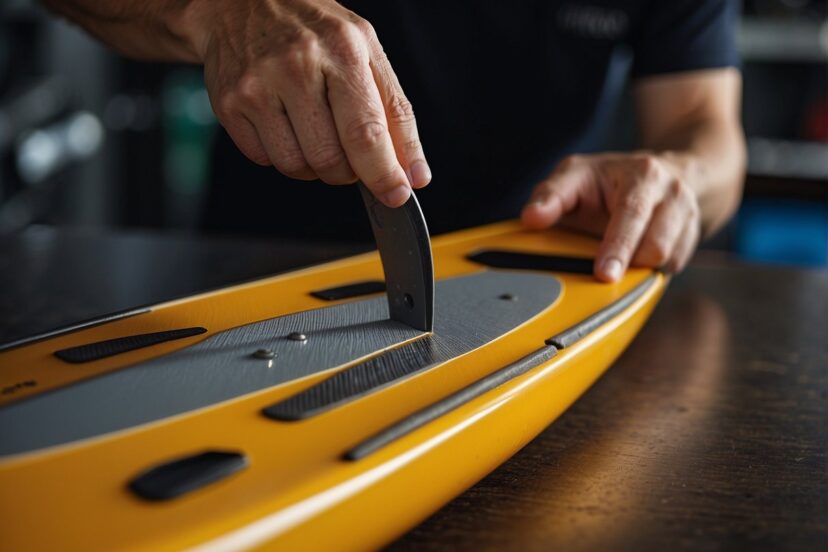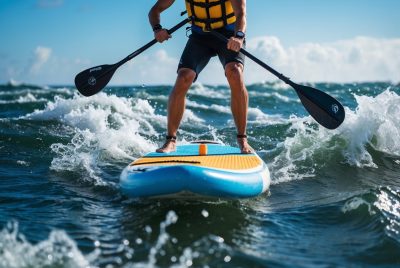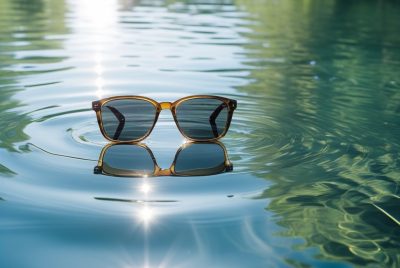Paddle Board Fin Replacement Guide: Essential Tips
*We may earn a commission for purchases made using our links. Please see our disclosure to learn more.
Paddle Board Fin Replacement Guide: Essential Tips for Selecting and Installing New Fins
So when is the time for your paddle board fin replacement? Selecting the right fin for my paddle board is an essential part of ensuring stability and maneuverability on the water. As an avid stand-up paddle boarder, I understand the various factors that can influence the performance of my board, starting with fin configuration. Whether it’s due to wear and tear, loss, or a desire to optimize for different conditions, replacing a fin is a routine part of maintaining my equipment. The fin setup, including deciding between single or multiple fins, affects how the board tracks through water, impacts its ability to catch waves for those who surf, and contributes to the overall feel when paddling.

The type of fin box on my paddle board also plays a crucial role in the kind of replacement fin I can use. Fin boxes are the slots on the underside of the board where fins are attached, and they come in various types, including standard long board boxes and newer ‘slide-in’ systems. The choice of fins and their placement in these boxes can be the difference between a smooth, stable ride and a challenging day on the water. My goal is to find a balance between grip for straight tracking and the right amount of resistance for effective turns.
When it’s time for me to replace my paddle board fin, I consider not only the fin’s size and shape but also the ease of installation. Tabs or other securing mechanisms are part of modern fins, which often allow for tool-free replacement, making it quick and easy to switch out on the shore. By taking into account these aspects, I ensure that my time on the water is both enjoyable and safe, with my equipment functioning at its best.
Understanding Paddle Board Fins

In this section, I’ll guide you through the varieties of paddle board fins, the influence they have on the board’s performance, and the key components of a fin system.
Fin Types and Designs
Paddle board fins come in different shapes and designs, each serving a specific purpose. The single fin setup is commonly used for simple, straight-line paddling, providing good tracking and stability. Side fins, also known as thrusters, are usually paired with a central fin in a 2+1 arrangement, offering enhanced maneuverability. The quad fin setup involves four fins for greater speed and control in waves. Lastly, the 4+1 configuration combines the adaptability of a single fin with the performance of a quad setup.
Shapes of Fins:
- Straight-edged fins: Boost speed and tracking.
- Curved fins: Enhance maneuverability.
Impact of Fins on Performance
The design of SUP fins greatly affects a board’s performance. A well-chosen fin can improve the speed, control, and stability of the paddle board. For instance, a larger fin assists with straight-line tracking, while a smaller, swept-back fin improves turning ability. Knowing the conditions I’ll paddle in and my performance needs helps me choose the correct fin setup.
Performance Factors:
- Speed: Longer fins with less drag improve speed.
- Control: Smaller fins offer more maneuverability.
- Stability and Tracking: Larger fins provide better stability and straighter tracking.
Anatomy of a Fin System
A paddle board fin system consists of the fin itself, the fin box where it’s mounted, and the securing mechanism. The fin box is typically a slot on the bottom side of a SUP board that holds the fin in place using screws or a snap-in system. The materials used for fins range from plastic to fiberglass or carbon, each offering a different balance of flexibility and rigidity.
Components:
- Fin Box: The slot on the underside of the SUP board.
- Securing Mechanism: Screws or snap-in systems that hold the fin in place.
- Materials: Varieties include plastic, fiberglass, and carbon.
Through understanding the different fin types and how they impact board performance, along with the anatomy of a fin system, I can make informed decisions on fin replacement to enhance my SUP experience.
Step-by-Step Paddle Board Fin Replacement

Replacing a fin on a paddle board is critical for maintaining performance and steering. Here’s how I handle the process efficiently and effectively.
Removing the Old Fin
To remove the old fin from the paddle board, I make sure the board is on a stable surface and the fin area is clean. If it’s a screw and plate fin system, I use a screwdriver to loosen the screw connecting the fin to the board. For a quick-release fin, I simply press the release tab and slide the fin out of the fin box. I ensure not to force the fin out to avoid damage to the fin box.
Selecting a New Fin
When I’m selecting a replacement fin, I consider if the fin is universal or specific to the board brand. Universal fins are widely available and fit most boards. I examine the fin placement for my board’s activities; a center fin provides straight tracking for touring, while side fins improve stability for surfing. The fin material also influences my decision; plastic fins offer durability, while fiberglass or carbon fins are lighter and offer better performance.
Installing the New Fin
Installing the new fin is usually a reversal of the removal process. I clear any debris from the fin box and align the new fin with the slot. If it’s a screw and plate fin system, I position the plate inside the fin box, slide the fin over it, and tighten the screw securely. For a tab system, I insert the fin’s front tab into the fin box, then lower the back of the fin until it clicks into place. Some fins may have a pin or a slot at the back that needs to be aligned before securing. For boards that use a quick-release mechanism, I ensure the tab is locked to secure the fin to the board.
Choosing the Right Fin for Your Board

When I replace a fin on my paddle board, I pay close attention to its compatibility, how it will perform in various water conditions, and how it aligns with my riding style.
Fin Compatibility for Paddle Board Fin Replacement
Stand-up paddle boards (SUPs), including inflatable paddle boards (iSUPs), feature different fin boxes—like the US fin box, slide-in fin box, dual tab box, and the snap-in lever box—which dictate the type of fin you can install. For inflatable models, the snap-in lever box or slide-in fin box are common, allowing for quick changes. Rigid SUPs often come with a US fin box, which is universal, enabling a wider variety of fin choices.
- US Fin Box: Works with a larger single fin and offers adjustable positions forward and backward.
- Slide-in Fin Box: Usually a single fin setup, easy to slide and secure without tools.
- Dual Tab Box: Compatible with certain twin-fin setups.
- Snap-in Lever Box: Provides a quick and tool-free installation, often seen in iSUPs.
Considerations for Different Water Conditions
The water conditions play a significant role in the choice of fin. For flat water found in lakes and slow-moving rivers, a larger fin that offers better tracking and glide is ideal. It improves straight-line paddling efficiency.
- Flat Water: Choose a fin with more depth for stability.
- Surfing: Smaller, more flexible fins that improve maneuverability.
- Racing: Longer, straighter fins reduce drag.
- Touring: Larger fins with a swept-back design for long-distance travel.
Customization for Riding Style
My riding style impacts my fin choice. A single fin setup is versatile for general use. When I focus on surfing, a tri-fin configuration enhances my maneuverability in the waves. For racing, I look for a fin designed to cut through the water with minimal resistance to increase speed. For touring, a stiffer and larger fin supports long distances by improving stability.
- Maneuverability:
- Smaller, flexible fins for sharper turns.
- Speed:
- Streamlined fins with less drag for racing.
- Stability:
- Larger fins with more surface area for touring.
By matching the fin to the SUP type, water conditions, and riding preferences, I ensure an optimal experience on the water.
Maintenance and Care for Longevity

For paddle board fins, longevity hinges on proactive maintenance and careful handling. I focus on regular inspection and thorough cleaning alongside smart storage and transport methods to ensure my fins stand the test of time.
Regular Inspection and Cleaning
I make it a habit to inspect my fins after each outing, looking for signs of wear or damage. An inflatable board’s fins may not be as robust as those on a solid board, which means staying vigilant to maintain their integrity. For cleaning, I use:
- Freshwater Rinse: Immediately after use, I rinse my fins with fresh water to remove salt, sand, and other residues.
- Soft Cloth: With a gentle cloth, I wipe down the fins to safeguard against UV ray damage, especially important for brands like iRocker and ROC known for their durability.
- Occasional Deep Clean: Every few adventures, I do a deep clean with mild soap to keep the fins in prime condition.
Fin Storage and Transport
When it comes to storing and transporting my fins, I take no chances:
- Protective Case: Fins are stored in a padded case to prevent bending or breaking.
- Avoid Heat Exposure: I never leave my fins in direct sunlight for extended periods, as heat can warp or weaken the material.
For inflatable board fins that use a metal dowel and Phillips screwdriver for installation, I ensure the tools are handy and rust-free. This care extends the life of the fin and maintains its performance for many adventures on the water.
Advanced Tips and Accessories for Paddle Board Fin Replacement

When considering paddle board fin replacements, I focus on not just the immediate benefits but also the long-term enhancements and accessories that can significantly upgrade the paddling experience. My goal is to achieve precise control and improve tracking while ensuring my paddle board maintains stability and an optimal glide.
Fin Performance Enhancements
Tracking: The ability of a paddle board to maintain a straight path is closely linked to the fin design. I prefer fins that extend deeper underwater for better tracking, especially on flat water. When racing or tackling challenging waters, a longer fin can help me keep my board aligned with minimal correction strokes.
- Stability and Glide: A larger fin surface area typically offers more lateral resistance which can improve the overall stability of my stand up paddle board. This is essential for beginners or when I find myself on choppier waters. The right fin can also influence the glide of my board by reducing drag and maintaining speed.
Materials: Lightweight materials such as fiberglass or carbon can provide stiffness while keeping the fin light. I appreciate that a stiffer fin leads to more responsive paddling, especially when I maneuver the nose and tail around obstacles or through turns. However, inflatable paddle boards may benefit from more flexible fins for increased durability.
Top Tip: For inflatable paddle boards, which are naturally slower than their hardboard counterparts, replacing the standard flexible fin with a stiffer one can provide a noticeable difference in glide and tracking.
Accessories for Paddle Board Fins
Grip and Control: Accessories like fin leashes can prevent my fin from drifting away if it becomes detached during use. Additionally, fin protectors help guard the fin edges against damage which is essential to maintaining control on the water.
- Tools for Fin Installation: Stand up paddle boards often feature rails and boxes where fins are slotted in. Using a fin key or a screw set allows me to adjust the tightness of the fin within its box, ensuring it is firmly secured for optimal grip on the water.
Utilizing a tool-free fin system, if compatible with my paddle board, simplifies the process, enabling quick adjustments and replacements.
In my quest to enhance my paddling experience, considering these advanced tips and accessories for fin performance and additions is invaluable. I aim for a combination of enhanced control, superior stability, and an efficient glide, achieved through thoughtful selection of fins and utilization of supportive accessories.
Frequently Asked Questions
In this section, I address some of the most common questions regarding paddleboard fin replacement to help streamline the process for paddleboard enthusiasts.
1. How do you replace a fin on a paddleboard?
To replace a fin on a paddleboard, I start by clearing any dirt or debris from the fin box. I slide the fin’s base into the fin box track with the fin’s point facing the tail of the board. After aligning the hole in the fin with the hole in the fin box, I insert the pin or screw to secure it in place.
2. What factors determine the appropriate fin size for a paddleboard?
The appropriate fin size for a paddleboard depends mainly on the type of paddling I’ll be doing. Larger fins provide more stability and control for activities like surfing, while smaller fins make for better speed and maneuverability in flat water conditions. The weight of the paddler also influences the fin size choice.
3. Where can you purchase replacement fins for paddleboards?
Replacement fins for paddleboards can be purchased at water sports retailers, specialty paddleboarding stores, and online marketplaces. Brands like BOTE and FCS offer a variety of fins that are available directly from their websites or through authorized dealers.
4. Are replacement fins for stand-up paddleboards standardized?
Replacement fins for stand-up paddleboards are not entirely standardized. While there are common fin systems like US Box and FCS, the compatibility of fins can vary between different paddleboard brands and models. Always ensure the fin matches the board’s fin box system.
5. What components are included in a paddleboard fin replacement kit?
A paddleboard fin replacement kit usually includes the fin itself and the necessary hardware to secure the fin to the board, such as screws or pins. More comprehensive kits may also come with a fin key or tool to help tighten the hardware.




